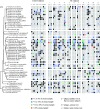Bacterial profiles of root caries in elderly patients
- PMID: 18385433
- PMCID: PMC2446847
- DOI: 10.1128/JCM.02411-07
Bacterial profiles of root caries in elderly patients
Abstract
Culture-based studies have shown that Streptococcus mutans and lactobacilli are associated with root caries (RC). The purpose of the present study was to assess the bacterial diversity of RC in elderly patients by use of culture-independent molecular techniques and to determine the associations of specific bacterial species or bacterial communities with healthy and carious roots. Plaque was collected from root surfaces of 10 control subjects with no RC and from 11 subjects with RC. The bacterial 16S rRNA genes from extracted DNA were PCR amplified, cloned, and sequenced to determine species identity. From a total of 3,544 clones, 245 predominant species or phylotypes were observed, representing eight bacterial phyla. The majority (54%) of the species detected have not yet been cultivated. Species of Selenomonas and Veillonella were common in all samples. The healthy microbiota included Fusobacterium nucleatum subsp. polymorphum, Leptotrichia spp., Selenomonas noxia, Streptococcus cristatus, and Kingella oralis. Lactobacilli were absent, S. mutans was present in one, and Actinomyces spp. were present in 50% of the controls. In contrast, the microbiota of the RC subjects was dominated by Actinomyces spp., lactobacilli, S. mutans, Enterococcus faecalis, Selenomonas sp. clone CS002, Atopobium and Olsenella spp., Prevotella multisaccharivorax, Pseudoramibacter alactolyticus, and Propionibacterium sp. strain FMA5. The bacterial profiles of RC showed considerable subject-to-subject variation, indicating that the microbial communities are more complex than previously presumed. The data suggest that putative etiological agents of RC include not only S. mutans, lactobacilli, and Actinomyces but also species of Atopobium, Olsenella, Pseudoramibacter, Propionibacterium, and Selenomonas.
Figures


Similar articles
-
Microarray analysis of the microflora of root caries in elderly.Eur J Clin Microbiol Infect Dis. 2009 May;28(5):509-17. doi: 10.1007/s10096-008-0662-8. Epub 2008 Nov 28. Eur J Clin Microbiol Infect Dis. 2009. PMID: 19039610 Free PMC article.
-
Bacteria of dental caries in primary and permanent teeth in children and young adults.J Clin Microbiol. 2008 Apr;46(4):1407-17. doi: 10.1128/JCM.01410-07. Epub 2008 Jan 23. J Clin Microbiol. 2008. PMID: 18216213 Free PMC article.
-
[Analysis of community composition in dental plaque of elder people with root caries].Zhonghua Kou Qiang Yi Xue Za Zhi. 2011 Oct;46(10):590-4. Zhonghua Kou Qiang Yi Xue Za Zhi. 2011. PMID: 22321627 Chinese.
-
The microbiology and histopathology of human root caries.Am J Dent. 1995 Dec;8(6):323-8. Am J Dent. 1995. PMID: 8695011 Review.
-
The uncultured microbial majority.Annu Rev Microbiol. 2003;57:369-94. doi: 10.1146/annurev.micro.57.030502.090759. Annu Rev Microbiol. 2003. PMID: 14527284 Review.
Cited by
-
Polymicrobial interactions: impact on pathogenesis and human disease.Clin Microbiol Rev. 2012 Jan;25(1):193-213. doi: 10.1128/CMR.00013-11. Clin Microbiol Rev. 2012. PMID: 22232376 Free PMC article. Review.
-
Administration of Clinical COVID-19 Mouthwashing Protocol and Potential Modulation of Pediatric Oral Bacterial Prevalence of Selenomonas noxia: A Pilot Study.Pediatr Rep. 2023 Jul 11;15(3):414-425. doi: 10.3390/pediatric15030038. Pediatr Rep. 2023. PMID: 37489412 Free PMC article.
-
Geographic Variation Did Not Affect the Predictive Power of Salivary Microbiota for Caries in Children With Mixed Dentition.Front Cell Infect Microbiol. 2021 Jun 18;11:680288. doi: 10.3389/fcimb.2021.680288. eCollection 2021. Front Cell Infect Microbiol. 2021. PMID: 34222048 Free PMC article.
-
Salivary levels of five microorganisms of root caries in nursing home elderly: a preliminary investigation.BMC Oral Health. 2023 Jun 3;23(1):355. doi: 10.1186/s12903-023-02953-9. BMC Oral Health. 2023. PMID: 37270529 Free PMC article.
-
Clonal analysis of the microbiota of severe early childhood caries.Caries Res. 2010;44(5):485-97. doi: 10.1159/000320158. Epub 2010 Sep 23. Caries Res. 2010. PMID: 20861633 Free PMC article.
References
-
- Billings, R. J., L. R. Brown, and A. G. Kaster. 1985. Contemporary treatment strategies for root surface dental caries. Gerodontics 120-27. - PubMed
-
- Bowden, G. H., J. Ekstrand, B. McNaughton, and S. J. Challacombe. 1990. Association of selected bacteria with the lesions of root surface caries. Oral Microbiol. Immunol. 5346-351. - PubMed
Publication types
MeSH terms
Substances
LinkOut - more resources
Full Text Sources
Other Literature Sources
Molecular Biology Databases
Miscellaneous

